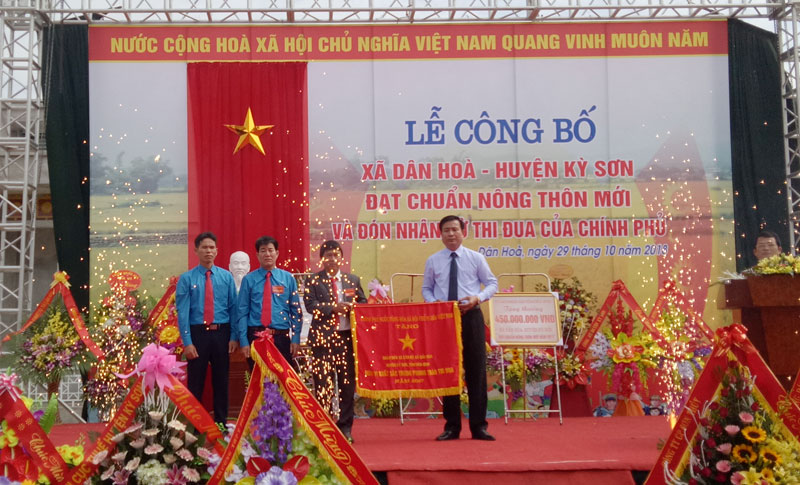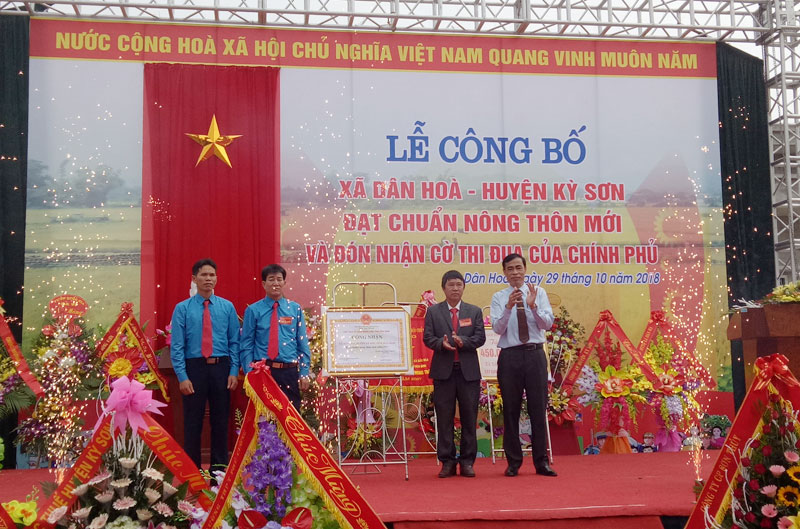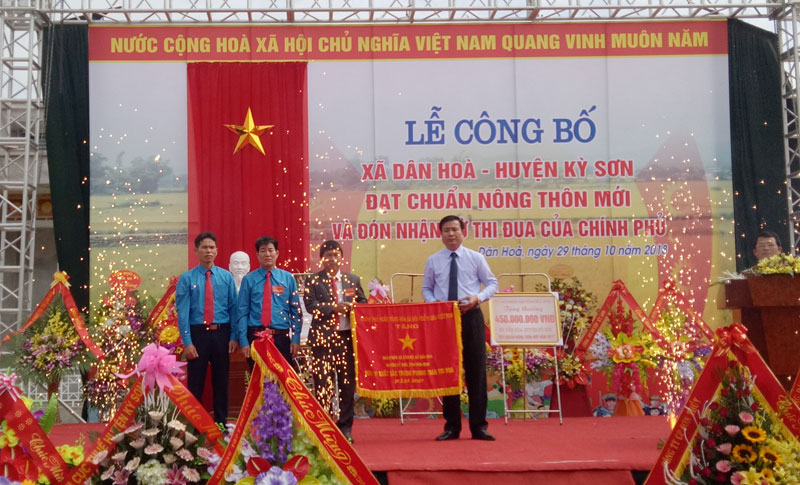
(HBO) – The People’s Committee of Ky Son district has organised a ceremony to receive the Prime Minister’s emulation flag and a certificate recognizing Dan Hoa commune as a new-style rural area.
Authorised
by the Prime Minister, leader of the Ky Son Party Committee presents the Prime
Minister’s emulation flag to the Party organisation, authorities and people of
Dan Hoa commune.
The
commune’s annual per-capita income increased from 16.5 million VND in 2011 to
32 million VND in 2017. Its poverty rate dropped from 6.25 percent in 2016 to
3.39 percent last year. The awareness of most officials and people on new-style
rural building has improved significantly. Grassroots-level democracy and
people’s responsibility have been raised, thus mobilizing many resources for
the new-style rural building. In the 2011-2017 period, Dan Hoa commune
mobilized nearly 93 billion VND for the progamme, of which over 8.7 billion VND
from the central budget, nearly 36 billion VND from the provincial and district
budgets, and over 27 billion VND from credits. Local residents donated cash and
working days to build infrastructure facilities. They also spent close to 21
billion VND on decorating houses, developing household economy and purchasing
machines serving production.
At present, 85.5 percent of local population are covered by health insurance
and 92 percent of labourers have regular jobs. The rate of trained workers
reaches 45 percent while more than 98 percent of households gain access to
hygienic water.

Authorised
by the Chairman of the provincial People’s Committee, leader of the Department
of Education and Training presents new-style rural area certificate to the
Party organisation, authorities and people of Dan Hoa commune.
Recognising the efforts by the communal Party organisation, authorities and
people in new-style rural building during 2011-2017, Dan Hoa received the
provincial People’s Committee’s certificate recognizing it as a new-style rural
area in 2017 and was presented a social welfare work worth 450 million VND. It
was also presented the Prime Minister’s emulation flag for excellently
fulfilling assigned tasks and leading the patriotic emulation movement in the
province in 2017.
On the occasion, five collectives and 10 individuals with great achievements in
implementing the new-style rural area building programme during 2011-2017 were
commended and rewarded by the district People’s Committee. The communal
People’s Committee presented certificates of merit to five collectives and 12
individuals./.
Hoa Binh province is undergoing a dynamic transformation amid Vietnam’s national digital transition. Building on Poliburo’s Resolution No. 57-NQ/TW on breakthroughs in science, technology, innovation, and national digital transformation, the province has rolled out a wide range of practical action plans. A standout initiative is the "Digital Literacy for All” movement, an effort to ensure that no one is left behind in the digital era.
Hoa Binh province is undergoing a dynamic transformation in the wake of the national digital transformation movement. Building on Resolution No. 57-NQ/TW of the Politburo on breakthroughs in science, technology, innovation, and national digital transformation, the province has implemented a wide range of practical action plans. A standout initiative is the "Digital Literacy for All” movement ambitious effort to ensure that no one is left behind in the digital age.
With a spirit of unity and proactive problem-solving, the Party Committee, the government and the people of Dong Lai Commune (Tan Lac District) have made great strides in implementing the resolutions of the 24th Party Congress of the commune for the 2020 - 2025 term. Focusing on leadership and practical actions, the commune has brought the Party’s resolutions into daily life, creating strong impacts and pushing the local development forward.
Amid the nationwide push for digital transformation, young people in Hoa Binh Province are stepping up as dynamic pioneers, applying technology to enhance Youth Union operations and expand the reach of youth-led initiatives. Through creativity and adaptability, Youth Union organizations at all levels have introduced a series of practical solutions, contributing to modern governance and community development.
In recent years, An Nghia commune, located in Lac Son district, has stepped up administrative reform, focusing on improving the quality and efficiency of its single-window service unit for receiving and processing administrative procedures. These improvements have helped create favourable conditions for local residents and organisations to handle administrative procedures, contributing to the commune’s broader socio-economic development.
The Prime Minister-approved master plan to develop the multi-use value of forests ecosystems through 2030, with a vision to 2050, aims to improve the management and sustainable use of forest resources, create jobs, increase incomes, and improve the living standards of ethnic minorities, people in mountainous and remote areas, forest workers and those living near forests.




